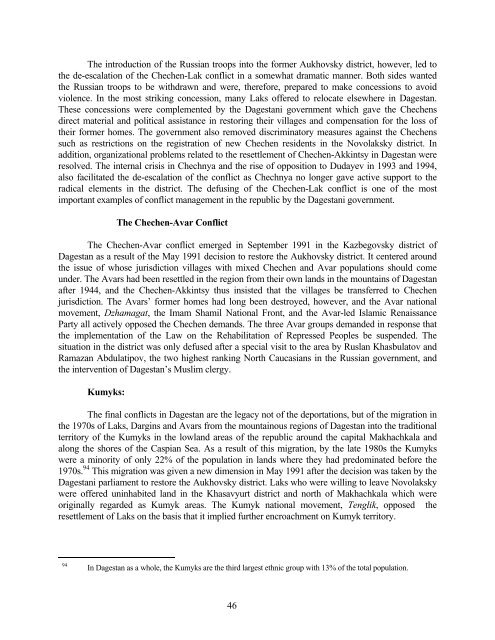RUSSIA'S TINDERBOX - Belfer Center for Science and International ...
RUSSIA'S TINDERBOX - Belfer Center for Science and International ...
RUSSIA'S TINDERBOX - Belfer Center for Science and International ...
You also want an ePaper? Increase the reach of your titles
YUMPU automatically turns print PDFs into web optimized ePapers that Google loves.
The introduction of the Russian troops into the <strong>for</strong>mer Aukhovsky district, however, led to<br />
the de-escalation of the Chechen-Lak conflict in a somewhat dramatic manner. Both sides wanted<br />
the Russian troops to be withdrawn <strong>and</strong> were, there<strong>for</strong>e, prepared to make concessions to avoid<br />
violence. In the most striking concession, many Laks offered to relocate elsewhere in Dagestan.<br />
These concessions were complemented by the Dagestani government which gave the Chechens<br />
direct material <strong>and</strong> political assistance in restoring their villages <strong>and</strong> compensation <strong>for</strong> the loss of<br />
their <strong>for</strong>mer homes. The government also removed discriminatory measures against the Chechens<br />
such as restrictions on the registration of new Chechen residents in the Novolaksky district. In<br />
addition, organizational problems related to the resettlement of Chechen-Akkintsy in Dagestan were<br />
resolved. The internal crisis in Chechnya <strong>and</strong> the rise of opposition to Dudayev in 1993 <strong>and</strong> 1994,<br />
also facilitated the de-escalation of the conflict as Chechnya no longer gave active support to the<br />
radical elements in the district. The defusing of the Chechen-Lak conflict is one of the most<br />
important examples of conflict management in the republic by the Dagestani government.<br />
The Chechen-Avar Conflict<br />
The Chechen-Avar conflict emerged in September 1991 in the Kazbegovsky district of<br />
Dagestan as a result of the May 1991 decision to restore the Aukhovsky district. It centered around<br />
the issue of whose jurisdiction villages with mixed Chechen <strong>and</strong> Avar populations should come<br />
under. The Avars had been resettled in the region from their own l<strong>and</strong>s in the mountains of Dagestan<br />
after 1944, <strong>and</strong> the Chechen-Akkintsy thus insisted that the villages be transferred to Chechen<br />
jurisdiction. The Avars’ <strong>for</strong>mer homes had long been destroyed, however, <strong>and</strong> the Avar national<br />
movement, Dzhamagat, the Imam Shamil National Front, <strong>and</strong> the Avar-led Islamic Renaissance<br />
Party all actively opposed the Chechen dem<strong>and</strong>s. The three Avar groups dem<strong>and</strong>ed in response that<br />
the implementation of the Law on the Rehabilitation of Repressed Peoples be suspended. The<br />
situation in the district was only defused after a special visit to the area by Ruslan Khasbulatov <strong>and</strong><br />
Ramazan Abdulatipov, the two highest ranking North Caucasians in the Russian government, <strong>and</strong><br />
the intervention of Dagestan’s Muslim clergy.<br />
Kumyks:<br />
The final conflicts in Dagestan are the legacy not of the deportations, but of the migration in<br />
the 1970s of Laks, Dargins <strong>and</strong> Avars from the mountainous regions of Dagestan into the traditional<br />
territory of the Kumyks in the lowl<strong>and</strong> areas of the republic around the capital Makhachkala <strong>and</strong><br />
along the shores of the Caspian Sea. As a result of this migration, by the late 1980s the Kumyks<br />
were a minority of only 22% of the population in l<strong>and</strong>s where they had predominated be<strong>for</strong>e the<br />
1970s. 94 This migration was given a new dimension in May 1991 after the decision was taken by the<br />
Dagestani parliament to restore the Aukhovsky district. Laks who were willing to leave Novolaksky<br />
were offered uninhabited l<strong>and</strong> in the Khasavyurt district <strong>and</strong> north of Makhachkala which were<br />
originally regarded as Kumyk areas. The Kumyk national movement, Tenglik, opposed the<br />
resettlement of Laks on the basis that it implied further encroachment on Kumyk territory.<br />
94 In Dagestan as a whole, the Kumyks are the third largest ethnic group with 13% of the total population.<br />
46
















